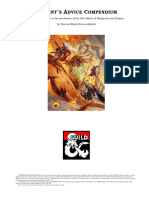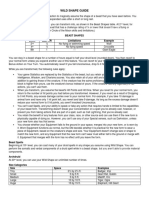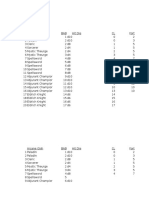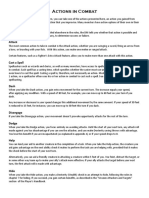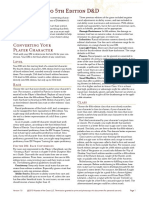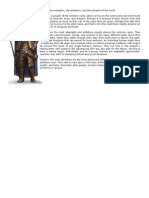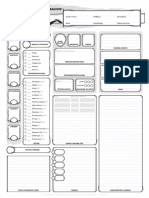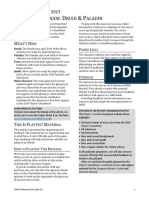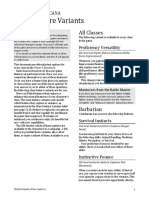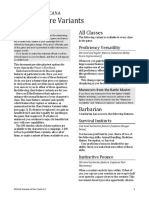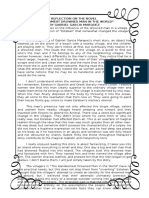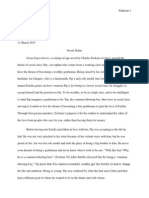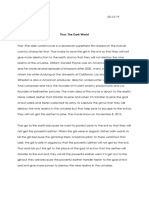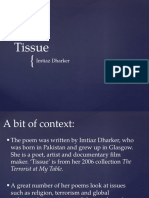ARTICLE
MODIFYING CLASSES
Looking for more advice on modifying character classes? Dive into customization
with some advice on class design.
Sometimes a campaign will have special needs for archetypes or character options not found
in the existing o cial material. If youre in this situation, you might want to modify one or
more of the classes in the game in order to provide options for players looking for a unique
twist on their characters abilities. However, modifying a class is not something that should be
undertaken lightly, and the job requires some serious e ort, playtesting, and revision to get it
right. The two best ways to modify a class are to swap out some class features for di erent
ones, and to add new to an existing class. This article presents methods that will help you to
use existing mechanics as a model, while drawing upon features of other classes for
inspiration.
You can think of the material presented in this series as similar to the rst wave of the fth
edition playtest. These game mechanics are in draft form, usable in your campaign but not
fully tempered by playtests and design iterations. They are highly volatile and might be
unstable; if you use them, be ready to rule on any issues that come up. Theyre written in
pencil, not ink. For these reasons, material in this column is not legal in D&D Organized Play
events.
The material presented in Unearthed Arcana will range from mechanics that we expect one day
to publish in a supplement to house rules from our home campaigns that we want to share,
from core system options to setting-speci c material. Once its out there, you can expect us to
check in with you to see how its working out and what we can do to improve it.
CREATING NEW CLASS OPTIONS
Each class contains at least one major decision point, referred to here as a class option. Clerics
choose a divine domain, ghters choose a martial archetype, rogues choose a roguish
archetype, wizards choose an arcane tradition, and so forth. If you want to create a di erent
�archetype, wizards choose an arcane tradition, and so forth. If you want to create a di erent
version of one of these major decision points (such as a new primal path for the barbarian),
examine the existing examples to see how they are built. As with anything in class design, be
prepared to playtest your ideas and then make changes if things arent turning out the way
you want them to.
The rst thing to do when creating a new class option is to gure out what that options
unique aspect is, both in terms of the classs underlying story and the options place in the
campaign world. Figuring out the story behind the class option, and what kinds of characters
you want to enable your players to create with it, is the most critical step in the process
because it will serve as a guiding example for you.
Once you have a unique concept for your class option in mind, its time to get down to the
design process. Take a look at the classs existing options and see what they provide, and then
use those as examples or building blocks for the features that your class option will provide.
Its perfectly ne for two class options in the same class to share some mechanics, and its also
appropriate to examine other classes for mechanics you can draw upon for inspiration. At
every step along the way, you can compare what you are designing with your original concept,
and, if the design is helping to de ne and establish that concept, you know youre on the right
path. On the other hand, if your design for a mechanic isnt somehow helping to reinforce the
theme of the new class option, it might be worthwhile to reconsider that mechanic.
As you consider which class features to include in your new class option, address the following
questions:
What kinds of abilities do the other options for this class provide at comparable levels?
Do the features improve a characters combat ability directly, make the character better at
exploration or interaction, or provide alternatives that arent about a pure increase in
power?
How do the features at a given level reinforce the story of that class option?
Does an existing mechanic already accomplish something that the new class option also
needs to do?
�CLASS-SPECIFIC GUIDELINES
As it says in the Dungeon Masters Guide, no formula exists that can be used to perfectly design
a new or replacement class feature, but some guidelines do apply for each of the eleven
classes. While this advice is by no means comprehensive, it should provide a few points to
ponder and get you thinking about how a classs features should work together.
Often, as youll see, the best advice is to leave things as they are. Many classes have deeply
ingrained qualities, such as how they receive and cast spells, that dont lend themselves to
being tinkered with. Even if some parts of the class descriptions are o limits for our purposes
here, there are still plenty of opportunities for you to develop variant features within each
class.
BARBARIAN
Though the barbarians Rage class feature grants the class a signi cant increase in
defensive strength, be aware of how other class features interact with Rage to boost the
characters o ensive potency. For example, the primary drawback of Reckless Attack is
largely o set by the damage resistance provided by Rage, and the berserkers Frenzy
feature gives the barbarian a lot of attack power for at least one combat.
Note that Fast Movement serves three important purposes: getting the barbarian to the
�Note that Fast Movement serves three important purposes: getting the barbarian to the
front line of a battle quickly, preventing the barbarians rage from ending because an
enemy is not nearby, and encouraging the barbarian to stay out of heavy armor.
The 10th-level features of both Primal Paths speaks more to the interaction pillar of the
game than to combat; be wary of replacing or altering them to add combat potency.
The 6th-level bene t of the Path of the Totem Warrior generally speaks to the exploration
pillar of the game, so think twice before changing it, for the same reason as above.
BARD
Bards have the full spellcasting progression; any changes to the Spellcasting feature will
have a big impact on the class.
Bards know a limited number of spells, which is a restriction on their versatility that
should be modi ed with care when making changes to the class. Bards of the College of
Lore receive an expansion of their number of spells known as a full class feature.
Font of Inspiration, gained at 5th level, helps encourage the bard to continue along the
classs path for at least ve more levels in order to make better use of Bardic Inspiration.
Be wary of developing similar mechanics for other classes, because a feature that hands
out a true increase to a numerical result (instead of advantage and disadvantage) should
be rare.
CLERIC
Clerics have the full spellcasting progression; any changes to the Spellcasting feature will
have a big impact on the class.
A cleric domain has a strong, de ning class feature that fundamentally a ects the way
that character plays. The 1st-level feature in a domain, whether the domain is one youre
creating or one youre modifying, should be something that really makes clerics of that
domain stand out.
Domain spells were typically chosen to expand the clerics options, while the base spell list
of the cleric was kept relatively short. Look to other classes spell lists when searching for
spells to add to a new domain. For instance, the Light domain o ers a number of spells
that arent on the clerics list.
DRUID
Druids have the full spellcasting progression; any changes to the Spellcasting feature will
have a big impact on the class.
Wild Shape is used largely for exploration purposes by Circle of the Land druids. For Circle
of the Moon druids, Wild Shape o ers signi cant defensive advantages, making such
characters very durable.
As with cleric domain spells, Circle of the Land druids circle spells are frequently drawn
from the spell lists of other classes to increase those characters versatility.
FIGHTER
Fighters gain most of their combat prowess from three characteristics of the class: being
�Fighters gain most of their combat prowess from three characteristics of the class: being
able to make up to four attacks per round; using Action Surge to grant quick bursts of
combat potency; and having the highest number of Ability Score Improvement features,
which allows ghters to strengthen their attacks and saving throws, or, if the DM allows it,
select feats.
The ghter archetypes are largely meant to be di erent avors of the base class, in which
most of the ghters combat strength lies. The Champion gains some versatility and a
better chance of scoring critical hits. The Battle Master specializes in maneuvers that
arent available to other ghters. The Eldritch Knights ability to cast spells sets that
archetype apart, while being limited enough so that the character still feels like a ghter.
Note that the 7th-level features for the Champion and the Battle Master lean heavily on
the exploration and interaction pillars of the game; the Eldritch Knight gains spells, which
contribute to the ghters competence in the exploration and interaction pillars, and so its
7th-level feature is geared to blending spells and attacks.
MONK
The monk is one of the most complex classes, with the highest number of unique class
features. Be wary of replacing a single feature with more than one new feature, since the
class already has a lot of capability.
The monks Martial Arts feature was carefully worded to prevent unintended
combinations; this is why the feature does not treat unarmed strikes as a nesse weapon,
since that could have unforeseen consequences in future material about nesse weapons
that is appropriate for, say, a rapier or a dagger but not an unarmed strike.
Ki points have some subtle guidelines in how they are expended; features that cost 1 ki
point usually focus on utility, or are the equivalent of a single unarmed strike. Features
that cost 2 ki points should be on par with a 1st-level spell, while a feature that costs 3 ki
points should be on par with a 2nd-level spell. Examine the elemental disciplines of the
Way of the Four Elements monk for further examples of how to match ki points to spell
levels.
PALADIN
Paladins have a spellcasting progression that is half as vigorous as the normal
progression. The Spellcasting feature can be tinkered with a bit, but it still needs to be a
signi cant portion of what the class can do.
Paladins derive a large amount of their combat potency from the Divine Smite class
feature. Since the paladin can wait until after determining if an attack hits (or is a critical
hit) to use the smite, the character is capable of intense bursts of damage. Be wary of
tinkering with this feature, because it is fundamental to the paladins combat strength.
Many of the paladins class features are defensive in nature, protecting both the paladin
and his or her allies from harm. Swapping out defensive class features for o ensive ones
starts to alter the feel of the paladin, perhaps in ways you did not intend.
RANGER
Rangers have a spellcasting progression that is half as vigorous as the normal
�Rangers have a spellcasting progression that is half as vigorous as the normal
progression. The Spellcasting feature can be tinkered with a bit, but it still needs to be a
signi cant portion of what the class can do.
Much of the rangers extra potency in combat comes from spells such as hunters mark
and from the class features granted by the ranger archetypes. The 3rd-level feature in
each archetype usually either provides a raw increase in combat power, or grants the
ranger greater combat versatility.
Favored Enemy was intentionally designed to provide no combat bonus, because the
rangers strength in combat should not rely solely on the discretion of the Dungeon
Master or the circumstances of the adventure. Although the Hunter archetypes 3rd-level
ability does rely somewhat on the nature of the foes being fought, Favored Enemy is
generally useful in the interaction and exploration pillars of the game.
ROGUE
Rogues rely chie y on two features for both the classs feel and its strength in combat:
Sneak Attack and Cunning Action. These are fundamental to the rogue, and Uncanny
Dodge at 5th level is almost their equal in importance to the class. Leave these features as
is, unless you have a powerful reason for changing anything.
The class features granted by the roguish archetypes at 3rd level should fundamentally
alter the way the class plays, just as the clerics Divine Domain features do.
Rogues are the masters of skills, and the class already pushes the boundaries of what we
(and our playtesters) consider to be acceptable in terms of game balance. Giving them
more skill potency could push rogues over the line.
SORCERER
Sorcerers have the full spellcasting progression; any changes to the Spellcasting feature
will have a big impact on the class.
Like bards, sorcerers are have a limitation on the number of spells they can choose from,
which is a major restriction on the class.
The sorcerer does not get many metamagic choices. When you create a new metamagic
option, be sure that it is useful enough that a sorcerer could justify using one of his or her
precious choices on it.
Sorcery points and Flexible Casting were intentionally designed so that a sorcerer who
does nothing but convert spell slots to sorcery points in order to cast higher-level spells
does so at the cost of overall output. Be cautious when altering this balance.
WARLOCK
Warlocks have a unique spellcasting method, and they rely on being able to cast a smaller
number of spells more frequently. Remember that a warlock automatically increases the
spell slot level of spells he or she casts, meaning that even lower-level spells gain potency
when cast by a warlock.
The warlock spell list was carefully cultivated to avoid including spells that might become
annoying if cast too often at the table. If you want to grant a warlock access to a new spell,
but are concerned that its frequent casting could be disruptive to the game, consider
�but are concerned that its frequent casting could be disruptive to the game, consider
creating an eldritch invocation that enables the use of the same magic on a more limited
basis (by requiring a rest between uses, for instance).
Warlocks derive a lot of their combat potency from the eldritch blast cantrip, and already
have a lot of invocations to choose from to increase that reliance. Be wary of creating new
invocations that make eldritch blast even more powerful.
WIZARD
Wizards have the full spellcasting progression; any changes to the Spellcasting feature will
have a big impact on the class.
Wizards have the longest spell list and the broadest selection of spells to choose from
each day, thanks to their spellbooks. Anything that further increases their versatility in
this respect should be approached with caution.
The Arcane Traditions serve three purposes, which you should consider when creating
new ones: encouraging the casting of certain kinds of spells, providing utility that is
unique to specialists of a particular kind of magic and that cannot be found within spells,
and subtly altering the play style of the wizard without fundamentally drawing the thrust
of the class away from spellcasting.
EXAMPLE: RANGERS WITH NO SPELLS
As an example of what the class feature
replacement process might be like, we will
remove spellcasting from the ranger class. Lets
say that in your campaign you want rangers to
be a little bit more like Strider from the Lord of
the Rings, and less overtly magical from the
outset.
The Spellcasting class feature has a big impact
on the ranger class, so this is no small project.
Start by evaluating what the Spellcasting
feature is contributing to the class. In general,
rangers have a more limited spell list (and know
only a relatively small number of spells), and
operate on the same half-speed progression for
spellcasting as the paladin does. Looking over
the rangers spells, you might come to the
following conclusions about what the
Spellcasting feature contributes to the class:
Rangers have a lot of exploration utility in
their spells, with access to magic such as
detect poison and disease, beast sense, and
conjure animals.
Rangers gain a lot of their combat potency from spells, especially hunters mark.
�Rangers gain a lot of their combat potency from spells, especially hunters mark.
Rangers get some healing and restoration ability from spells such as cure wounds, lesser
restoration, and protection from poison, which stave o the harm an adventurer might
su er while exploring in the wilderness.
Rangers get some combat control e ects from their spells such as ensnaring strike, spike
growth, and conjure barrage, all of which give the ranger a magical edge in combat.
At some levels at which the ranger gains access to new spell levels, this is the only class
feature the character receives. As a result, the ranger will need additional class features at
those levels to prevent them from providing nothing to the ranger aside from increased
hit points.
Given the usefulness of the cure wounds spell, and the greater need for healing at lower levels,
lets create a healing class feature that allows the ranger to create and apply herbal poultices
an improvement that is on par with drinking a potion at rst, but one that will scale up as
the ranger gains levels.
Additionally, since the ranger is likely to need some extra combat utility that spells would
normally provide, lets add a version of the Combat Superiority class feature drawn from the
Battle Master ghter. The maneuvers that Combat Superiority grants can provide a nice boost
in combat, especially in matters of battle eld control. Looking at the ghter class, we can see
use cookies on this site to enhance your user
that theWe
Battle
Master ghters Combat Superiority is sitting in a similar
space as the
Yes,Iagree
experience.
spellcasting progression of the Eldritch Knight. We dont want the ranger to outshine the
By clicking Yes, I agree you are giving your consent for us
Battle Master
ghter, so were going to start the ranger with fewer maneuvers, scaling up as
to set cookies. (Learn more about cookies)
No,Iwanttofindoutmore
the ranger gains levels. Since were going to be replacing a one-half spellcasting progression,
this means that well need a few other features to bring this ranger up to par.
At 9th and 13th levels are gaps where we can place some exploration-focused mechanics.
Lets model the rst one on the protection from poison spell, and also give the poultice-creating
class feature an improved e ect. The second one we can model on the conjure animals spell,
which can be useful both in exploration scenes and in combat scenes.
At 17th level is another gap, which we can x with an improvement on Combat Superiority.
Fortunately, the Battle Master has a class feature that would t in well in the concept of this
ranger, so we can swap in the Relentless feature to make sure the ranger always has at least
some ability to exercise control over the battle eld, even in the later part of an adventuring
day.
Finally, we need to consider the impact of these changes on other class features, and make
adjustments as necessary. For example, the Beast Master archetype for the ranger has a
Share Spells class feature at 15th level that will no longer work without a Spellcasting feature.
If your non-spellcasting ranger decides to play a Beast Master, you will need to create a
substitute class feature for Share Spells as well, perhaps something to help keep the rangers
beast companion alive longer. Additionally, since Primeval Awareness requires the ranger to
expend spell slots to activate the class feature, we can modify that feature to allow the ranger
to use it once and regain its use after nishing a short or long rest.
Here are the full descriptions of the new class features for our spell-less ranger:
COMBAT SUPERIORITY
�COMBAT SUPERIORITY
At 2nd level, you learn maneuvers that are fueled by special dice called superiority dice.
Maneuvers. You learn two maneuvers of your choice, which are chosen from the list of
maneuvers available to ghters with the Battle Master archetype. Many maneuvers enhance
an attack in some way. You can use only one maneuver per attack.
You learn one additional maneuver of your choice at 5th, 9th, 13th, and 17th levels. Each time
you learn a new maneuver, you can also replace one maneuver you know with a di erent one.
Superiority Dice. You have four superiority dice, which are d8s. A superiority die is expended
when you use it. You regain all of your expended superiority dice when you nish a short or
long rest.
You gain another superiority die at 9th level and one more at 17th level.
Saving Throws. Some of your maneuvers require your target to make a saving throw to resist
the maneuvers e ects. The saving throw DC is calculated as follows:
Maneuver save DC = 8 + your pro ciency bonus + your Strength or Dexterity modi er (your
choice)
We use cookies on this site to enhance your user
POULTICES
experience.
Yes,Iagree
By clicking
agree you
are giving
your consent
for us
At 3rd level,
you Yes,
canIcreate
special
herbal
poultices
that have healing power comparable to
to set cookies. (Learn more about cookies)
No,Iwanttofindoutmore
some potions. You can spend 1 hour gathering herbs and preparing
herbal poultices using
treated bandages to create a number of such poultices equal to your Wisdom modi er
(minimum 1). You can carry a number of poultices at one time equal to your Wisdom modi er
(minimum 1). The poultices you create cannot be applied by anyone but you. After 24 hours,
any poultices that you have not used lose their potency.
If you spend 1 minute applying one of your poultices to a wounded humanoid creature,
thereby expending its use, that creature regains 1d6 hit points for every two ranger levels you
have (rounded up).
NATURAL ANTIVENOM
Starting at 9th level, you have advantage on saving throws against poison and have resistance
to poison damage. Additionally, you can use one of your poultices to cure one poison e ect on
the creature you are applying it to, in addition to restoring hit points.
CALL NATURAL ALLIES
Starting at 13th level, when you are in an area of your favored terrain, you can call natural
creatures from that terrain to ght on your behalf, using your attunement to the natural world
to convince them to aid you. The DM chooses beasts appropriate to the terrain to come to
your aid from among those that could hear you and that are within 1 mile of you, in one of the
following groups:
One beast of challenge rating 2 or lower
Two beasts of challenge rating 1 or lower
Four beasts of challenge rating 1/2 or lower
�Four beasts of challenge rating 1/2 or lower
Eight beasts of challenge rating 1/4 or lower
These beasts approach you from their current location, and will ght alongside you, attacking
any creatures that are hostile to you. They are friendly to you and your comrades, and you roll
initiative for the called creatures as a group, which takes its own turns. The DM has the
creatures statistics.
After 1 hour, these beasts return to their previous location. Once you use this feature, you
cannot use it again in the same general area for 24 hours, since the same animals will not
repeatedly heed your call.
RELENTLESS
Starting at 17th level, when you roll initiative and have no superiority dice remaining, you
regain 1 superiority die.
As a replacement for Share Spells, we could also consider the following feature:
BEASTLY COORDINATION
Beginning at 15th level, when an attacker that you can see hits your beast companion with an
We use
cookies
on this
site to enhance
your
user companion can hear you, it can use its
attack, you
can
call out
a warning.
If your
beast
Yes,Iagree
experience.
reaction to halve the attacks damage against it.
By clicking Yes, I agree you are giving your consent for us
to set cookies. (Learn more about cookies)
No,Iwanttofindoutmore
EXAMPLE: FAVORED SOUL
As an example of how creating a new class option could work, lets examine a design that was
a full- edged class in the third edition supplement Complete Divine: the favored soul. This
might be an appealing archetype if you are running a game where the gods are going to have
a big impact on the world, and where the Chosen of those gods (individuals bestowed with a
fragment of a gods divine power) are prominent players in the campaign. To re ect this tone,
lets create the Favored Soul as a new origin for the sorcerer class. This decision re ects the
idea that the character is someone who is fundamentally changed by the touch of his or her
deity, which awakens powerful magical abilities.
Looking at the existing sorcerous origins, we can determine that, at 1st level, an origin
provides not only the explanation for the source of the sorcerers power, but also a ourish on
the way that character plays. Since this sorcerer is going to be gaining its magic by being
imbued with divine power, we decide to give the Favored Soul access to some spells normally
gained by the cleric. Any time we expand the known spells of the sorcerer, we run the risk of
overshadowing the other sorcerous origins, since the limitation on the number of spells the
sorcerer knows has a big impact on how the class plays. This indicates that the other class
features probably shouldnt all tie closely to the sorcerers spellcasting, since that aspect of the
sorcerer is already getting quite a boost. Since the favored soul class was a little more martial
in its previous incarnation, we decide to give our sorcerer some better armor and access to
simple weapons, similar to the defensive bonuses gained by the Draconic Bloodline sorcerer
at 1st level.
At 6th level, the other sorcerous origins provide
�At 6th level, the other sorcerous origins provide
features that have an impact on the characters
combat abilities. Looking at the bard class, we
can see that the College of Valor gains the Extra
Attack class feature at the same level, and we
decide to give that to the Favored Soul to
further enhance its martial bent.
At 14th level, the sorcerous origins provide
some measure of utility, with little direct impact
on spellcasting or combat capabilities. Here, we
choose to model the Favored Souls feature
after the Draconic Bloodlines feature at the
same level, re ecting the touch of the divine
with some imagery typically associated with
divinity: wings.
At 18th level, the sorcerous origins provide
options that are both potent and strongly
linked to the origins central theme. Since the
sorcerer will have access to higher-level spells
at this level,
and
the on
feature
gave it your
at 1st
We use
cookies
this sitewe
to enhance
user
Yes,Iagree
experience.
level to provide some cleric spells wont have as
clicking
Yes, we
I agree
you are
your
consent for us
much ofByan
impact,
decide
togiving
tie this
class
cookies.
(Learn
moreboth
aboutto
cookies)
No,Iwanttofindoutmore
feature to
toset
those
cleric
spells,
incentivize the continued
use of those spells, and to give
the Favored Soul a little more resilience in the face of high-level threats.
When we are done with this initial design, heres what the Favored Soul sorcerous origin looks
like:
CHOSEN OF THE GODS
At 1st level, you choose one of the cleric classs divine domains. You add that domains spells
for 1st-level clerics to your known spells. These spells do not count against the number of
spells you can know, and they are considered to be sorcerer spells for you. When you reach
3rd, 5th, 7th, and 9th levels in the sorcerer class, you likewise learn your domains spells that
become available at those levels.
BONUS PROFICIENCIES
At 1st level, you gain pro ciency in light armor, medium armor, shields, and simple weapons.
EXTRA ATTACK
Starting at 6th level, you can attack twice, instead of once, whenever you take the Attack action
on your turn.
DIVINE WINGS
At 14th level, you gain the ability to sprout a pair of wings from your back (feathered or batlike, your choice), gaining a ying speed equal to your current walking speed. You can create
these wings as a bonus action on your turn. They last until you dismiss them as a bonus action
�these wings as a bonus action on your turn. They last until you dismiss them as a bonus action
on your turn.
You cant manifest your wings while wearing armor unless the armor is made to
accommodate them, and clothing not made to accommodate your wings might be destroyed
when you manifest them.
POWER OF THE CHOSEN
Starting at 18th level, when you cast one of the spells you learned from your Chosen of the
Gods class feature, you regain hit points equal to your Charisma modi er (minimum +1) + the
spells level.
In the end, the capabilities of our Favored Soul sorcerer are quite close to those of the
spontaneous-casting favored soul class from long ago!
ABOUT THE AUTHOR
Rodney Thompson is a senior designer for the Dungeons & Dragons game. In addition to
serving as a designer on the fth edition of D&D, he is the co-designer of the Lords of
Waterdeep
board
game
and
itstoexpansion.
is a graduate of the University of Tennessee
We use
cookies
on this
site
enhance yourRodney
user
and hasexperience.
worked at Wizards of the Coast since 2007, when he joined
the company as the lead
Yes,Iagree
designer
the Star
Saga Edition.
Byof
clicking
Yes, Wars
I agreeRoleplaying
you are givingGame
your consent
for us
to set cookies. (Learn more about cookies)
No,Iwanttofindoutmore
MODIFYING CLASSES PDF
Shares
FEATURED ARTICLE
Tweets
1+
�We use cookies on this site to enhance your user
DRUID CIRCLES
AND WILD SHAPE
experience.
UNEARTHED ARCANA - 11/28/2016
By clicking Yes, I agree you are giving your consent for us
By Mike Mearls and Jeremy Crawford
to set cookies. (Learn more about cookies)
Yes,Iagree
No,Iwanttofindoutmore
New options sprout for the druid this week: three new Druid Circle options and an optional rule for gaining
di erent beast shapes for Wild Shape. We invite you to read the options' descriptions, make characters
with...
MORE INFO
�We use cookies on this site to enhance your user
WATCHexperience.
FORCE GREY: THE LOST EPISODE
STREAMED LIVE ON DEC. 5TH - 11/17/2016
By clicking Yes, I agree you are giving your consent for us
Yes,Iagree
to set actors
cookies.and
(Learn
more about
cookies)
This summer,
comedians
from
The Sarah Silverman Program
and The Mindy Project
No,Iwanttofindoutmore
congregated at Meltdown Comics in L.A. to play a session of Dungeons & Dragons led by Matthew Mercer
(Critical Role,...
MORE INFO
�We use cookies on this site to enhance your user
TOY HALL
OF FAME
experience.
D&D INDUCTION - 11/10/2016
By clicking Yes, I agree you are giving your consent for us
Yes,Iagree
to set cookies.
(Learn more
about cookies)
Today, Dungeons
& Dragons
was inducted
into the National Toy HallNo,Iwanttofindoutmore
of Fame at the Strong Museum for
Play.
MORE INFO
LATEST WALLPAPER
�We use cookies on this site to enhance your user
VOLO'Sexperience.
GUIDE TO MONSTERS
WALLPAPER - 11/04/2016
By clicking Yes, I agree you are giving your consent for us
to set cookies. (Learn more about cookies)
LATEST GAMES
Yes,Iagree
No,Iwanttofindoutmore
